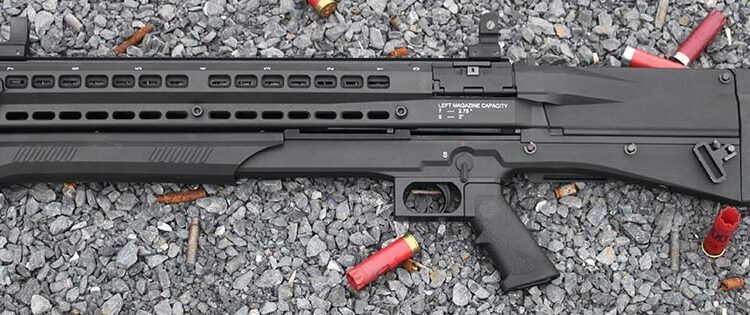By Todd Burgreen
UTAS is a Turkish company specializing in firearms design, engineering and manufacturing. UTAS is the Original Equipment Manufacturer (OEM) for many well known weapons that others have placed their name on here in the U.S. UTAS prides itself on specializing in innovative designs for law enforcement personnel, security conscience citizens, and sportsmen. Now they have succeeded in creating an interesting twist to the classic pump-action tactical shotgun in the form of the model UTS 15 shotgun. Their out-of-the-box thinking may very well turn the entire combat shotgun genre upside down with the UTS 15’s dual tube magazines resting over the barrel, bullpup configuration, and polymer construction. The UTS 15 is over 80 percent fabricated from fiber reinforced injection molded polymer. It is a fresh approach to the pump-action shotgun and sure to attract attention of law enforcement and civilians. Pump-action shotguns have been around for a relatively long time and are often too casually dismissed either as smoothbore relics associated with WWI trenches or police cruiser icons that have been surpassed by the overabundance of “black” rifles now on the market.
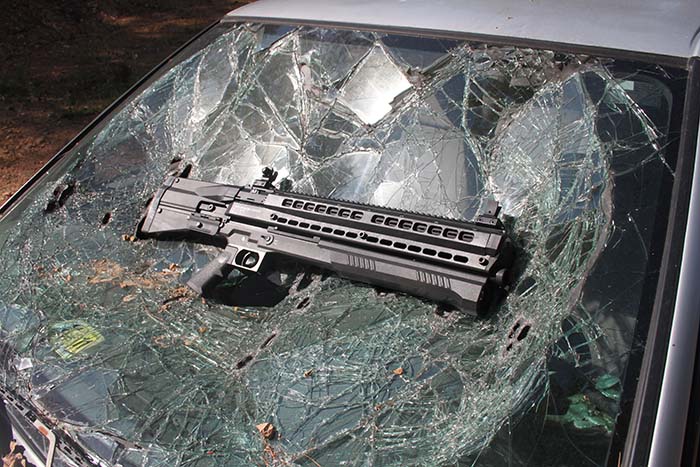
The story of the UTS 15 shotgun begins around 2006, when Smith & Wesson decided to explore expanding its line of shotguns with an unorthodox design based on improving the South African Neostead shotgun. At the time Smith & Wesson did not manufacture any of its shotguns in house; instead they utilized UTAS as an OEM and thus they turned to UTAS for the project as well. (As a sidenote, during this time, UTAS was also making shotguns for other U.S. brands like Savage-Stevens and Kimber.) UTAS obtained patent rights and samples of the Neostead shotgun from its designers. After initial evaluation UTAS decided to redesign the weapon completely, retaining its basic bullpup configuration and dual over-the-barrel magazines but create everything else from the ground up. All development work was carried out at the UTAS facility in Turkey. In 2008, Smith &Wesson withdrew from this project due to its internal problems while UTAS deciding to continue development of its new shotgun design under its own name.
Many would offer up the 12 gauge pump-action shotgun as the most utilitarian weapon option on the market. The operating standard for the tactical shotgun has been pump-action fed by a magazine tube located under the barrel since John Browning showed the way with the 1897. This is based on the 12 gauge pump-action shotgun’s simplicity, flexibility, reliability, price, and potency; especially considering ranges that typify law enforcement or home personal defense situations. Whatever the label, i.e. combat/tactical/self defense, shotguns can be had in various configurations ranging from double barrel, pump action, semiautomatic and for good measure even lever action. There have even been bolt action shotgun designs; none of these impinged on the pump action’s popularity based on reliability, ruggedness, able to handle a multitude of ammunition types, and ergonomics. The inherent flexibility of the shotgun, especially the pump-action, to digest a variety of cartridge types such as birdshot, slug, buckshot, non-lethal, low recoil or breaching is one of its greatest attributes.
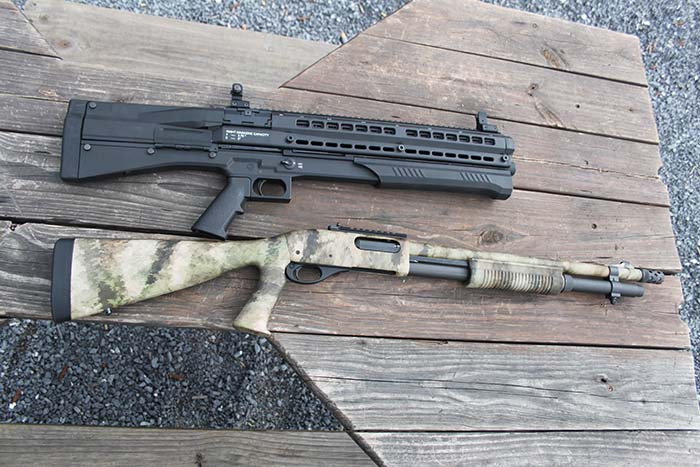
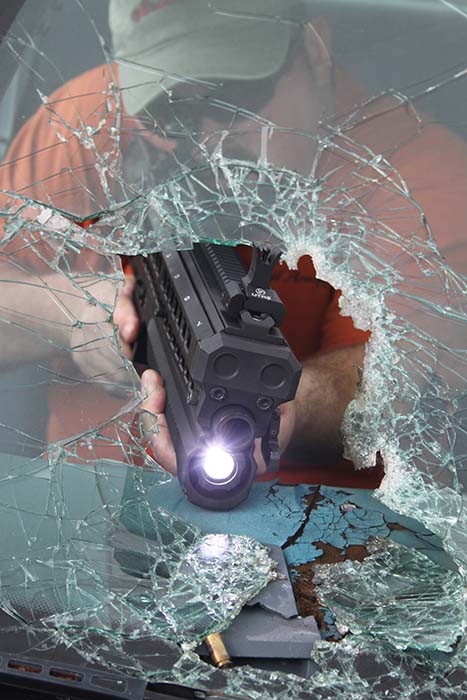
The UTS 15’s bullpup profile immediately grabs one’s attention with its unique aesthetics. Attempts at finding the exact origin of the term Bullpup came up with nothing definitive with a favorite being that in British usage a “Bulldog” was a heavy caliber revolver firing a .45 caliber bullet from a snub nose barrel. They were based on the Webley Police Revolver for the Royal Irish Constabulary. As most know, British police did not normally carry guns. However, a British policeman in Ireland who did not have a gun was tempting fate, so they wanted a powerful, yet compact weapon they could fit under their uniform. It was called “Bulldog” because the archetypical British breed Bulldog has a snub nose, similar to a revolver with a short barrel. Therefore, the British who were early innovators of the modern form of the “Bullpup” rifle associated the earlier term “Bulldog” i.e. a shortened or abbreviated form of a handgun, with the same form for a rifle and thus the endearing term “Bullpup” is born. Or so the story goes…
Bullpup style weapons have always generated strong opinions both for and against with both sides putting forth a litany of reasons regarding the concept to support their position. Advocates claim that nothing more than pointless moribund traditionalism stifles Bullpup-style weapons from being adopted widespread with detractors denigrating Bullpup effectiveness to the point of challenging the basic raison d’être for the design. Bullpups are firearm configurations in which the action is located behind the trigger group in the space normally solely reserved for the stock. This permits at least 7 to 10 inch shorter firearm length for the same barrel length thus improving maneuverability, handling and reducing weight. The UTAS UTS 15 features a full length 18.5-inch barrel yet has an overall length less than 28 inches. The compact size disguises great capacity with two 7-round tube magazines nestled over the barrel offering 14+1 capacity with 2 3/4 inch shotgun shells. The UTS can also accommodate 3 inch 12 gauge shells.
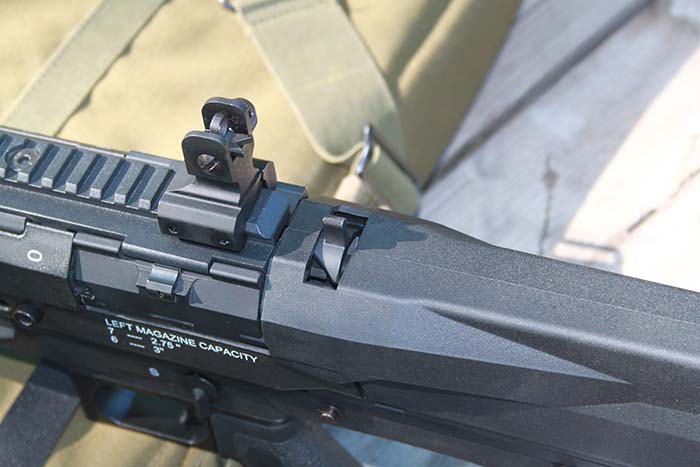
We should guard against inherent conservatism that runs deep in the gun culture when first evaluating the UTS 15 and keep an open mind. While more familiar traditional pump-action manual of arms needs to be tweaked with the UTS 15, it is worth the training effort as it offers a significant increase in the shotgun’s capacity – always a knock against the design. A pivoting selector switch located behind the magazine tube’s loading area allows a user to select between left or right magazine tube. Each magazine contains up to 7 rounds and has its own loading port on the side of the gun, so each magazine can be loaded independently. The loading ports have covers offering generous access to load shotshells once pulled back. The UTS 15 is provided with a large hinged top opening cover, which also serves as a comb of the stock, to ensure fast and convenient access to the action to check if the chamber is loaded or to clear an occasional jam in case of a deformed round. The UTS 15 shotgun is fitted with a rubber buttplate and several sling attachment points. Since the UTS 15 has its magazines located on top of the barrel, there is plenty of space inside the sliding forend guide below the barrel. This space has been maximized by UTAS via proprietary laser/light combo unit. The laser offers point and shoot characteristics perfect for shotgun and the tactical light is crucial equipment for any tactical weapon.
UTAS’s decision to utilize the compact bullpup profile with the UTS 15 minimizes the expected front heavy feel when both magazine tubes are fully loaded as would be the case with a standard profile pump action shotgun. Loaded tube magazines located above the barrel aids in keeping the muzzle down during firing. Slots along the magazine tubes allow a user to visually inspect how many rounds are available. The UTS 15’s ejection port is located on the right side of the gun and has a hinged dust cover that opens up automatically when the action is cycled. Its barrel has a chrome-lined bore and is provided with internal removable chokes. An AR-15/M16 style manual safety is located on the left side of the pistol grip. The right side of the grip is reserved for controls for the optional built-in laser/light unit. Barrel locking is achieved by conventional rotary bolt with three lugs that lock directly into the barrel extension.
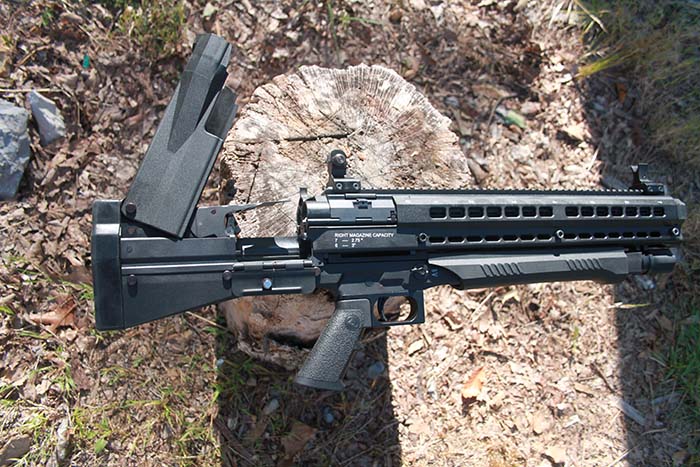
The UTS 15’s pump action proved smooth with a compact stroke. The pump release lever is located on the bottom of the buttstock and can be manipulated with either hand. A Picatinney rail runs along the top of the UTS 15 allowing for the mounting of a variety of sights. The AR style sights, especially with the large aperture selected, are similar to ghost ring sights commonly found on tactical shotguns. The sights proved proficient at placing slugs at a distance. Individual user preferences can be fully explored as to sight selection with red dot sight a consideration.
The eye opening and most unique feature of the UTAS UTS 15 is its compact Bullpup shape combined with two 7-round tube magazines above the barrel Range evaluations were twofold concentrating on determining if the dual tube magazines negatively impacted the UTS 15’s reliability in any way and if the Bullpup design magnified felt recoil. The UTS 15 weighs in at 7 pounds and has its own unique operational characteristics that need to be accepted for the most efficient use of the platform. The dual magazine tubes could be used to load certain types of shotgun ammunition in one side for breaching, for example, and then switch the selector to buckshot once through the door.
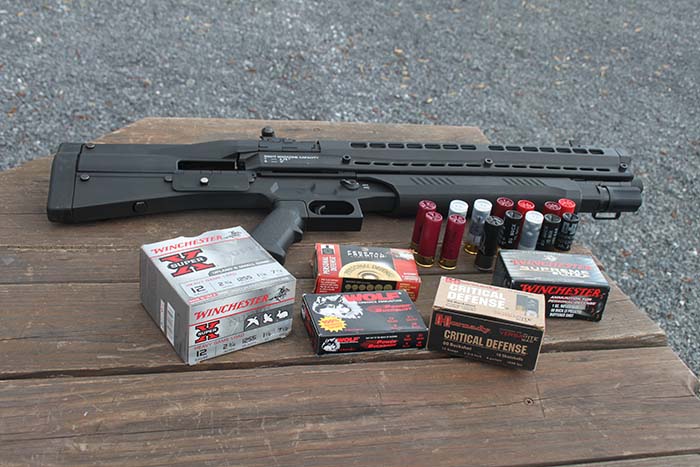
There is something re-assuring about the power of a shotgun for any close range engagement, which is what most civilians and LE face. The UTS 15 accentuates this feeling with its compact size yet higher than norm capacity. In terms of combat or personal defense, shotguns fire two primary types of shells – slugs or buckshot. This ability to handle different styles of projectiles is at the root of shotgun effectiveness and popularity with LE, military, and civilian users. (Many advocate the use of #7.5 or #8 birdshot in a shotgun for use in a home to limit any chance of over penetration. A column of birdshot at close range, such as across a room, is lethal due to not having time to disperse.)
The UTAS UTS 15 was tested with Hornady Critical Defense #00 buckshot (8-#00 pellets) and Federal Premium Personal Defense #00 buckshot (9 #00 pellets). Wolf and Winchester 1oz. slugs were utilized as well. Both slug loads were designed for hunting but work fine in any role including defense. Slugs leave the muzzle between 1,300-1,600 fps depending on particular manufacturer producing over 2,500 ft/lbs of energy and offer a ballistic track of +3 inches at 50 yards to give a 100 yard zero. The Hornady Critical Defense and Federal Premium buckshot loads utilize special wads for tighter buckshot patterns – thus longer effective range. Tighter patterns translate into more potent performance at ranges thought unrealistic for buckshot effectiveness. Low recoil Winchester and Federal buckshot and slug loads were also employed in testing the UTS 15. This is another advantage of the pump action in that a user or department does not have to worry about low recoil shotgun cartridges functioning with a pump action as compared to a semiautomatic action.
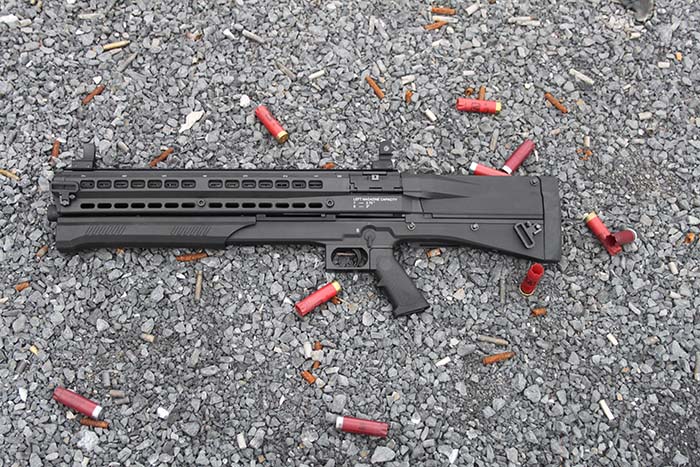
The UTS 15 generated a spread of 2-6 inches at 10 yards with the Federal and Hornady buckshot loads. This indicates that a shotgun must be aimed to ensure accurate shot placement. Both buckshot loads’ spread increased to 12-18 inches out to 30 yards. The UTS 15 with the Hornady Critical Defense 12 gauge #00 and Federal Personal Defense #00 was able to place four to five pellets on IPSC style silhouette targets out to 45yards. This is unheard of performance with standard buckshot loads.
Supplementing the standard slugs for testing with the UTS 15 was the innovative Winchester PDX 1 12ga loading combining a 1 ounce slug and three-#00 pellets. The Winchester PDX 1 12ga loads stretch preconceived 12ga lethality notions even further with its combination of slug and buckshot. Range testing of the Winchester PDX 1 raised eyebrows with its performance combining the best of both worlds for the combat shotgun – 100 yard slug single projectile performance and 15-20 inch buckshot pattern spread out to 30 yards with one of the holes being made by the 1oz slug. The Winchester PDX 1 had the same accuracy as dedicated slug only loads, 3 inch groups at 50 yards, with added benefit of three-#00 buckshot pellets allowing for shotgun multi-projectile performance. If only one load is possible for use in a combat shotgun, the Winchester PDX 1 may very well be it. It has the ability to eliminate the need for transitioning between buckshot and slug loads; thus eliminating the need for the infamous “switch to slug” drills employed in many training seminars.
The UTAS UTS 15 is all business with its matte black receiver, Bullpup rear stock, enlarged barrel with dual tube magazines resting above the barrel, and tactical light/laser the forend. The use of AR aperture sights take nothing away from the UTS 15’s pointability and quick shot placement required from a shotgun as numerous thrown clay targets were destroyed while testing at Echo Valley Training Center. The shotgun’s popularity is derived from the ability to hit targets at moderate ranges better than any other weapon with its cone of firepower via the numerous projectiles it can send downrange with a single trigger pull. The firing of 15 rounds of #00 buckshot translates into 135 projectiles sent downrange in a few seconds. The combat shotgun’s utility should not be doubted or held in disdain once its role is understood. Yes, the smaller individual buckshot pellets are comparable to a small caliber handgun in wounding potential, but multiple projectiles increase the likelihood of more hits and damage.
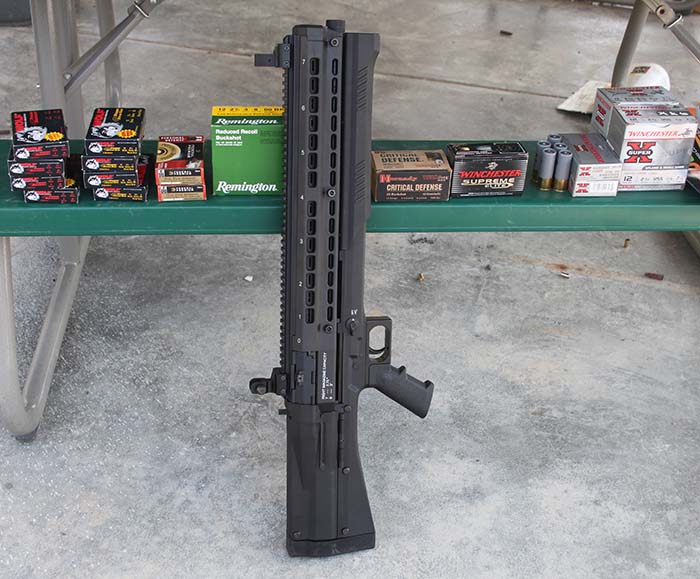
Typical of most pump-action shotguns, the UTS 15 proved simple, effective and reliable. The UTS 15 has received mixed reviews on the various internet forums and video channels. Near 250 rounds of various loads were fired in this T&E, including light birdshot, without issue. Range time consisted of the patterning described above along with other exercises trying to get a better appreciation of how the UTS 15 shotgun handles and performs. Drills involving moving between barricades engaging shoot and no-shoot targets were handled without issue. Yes, a shotgun can be viewed as limited in terms of range, but this is not necessarily a liability for civilians, LE and certain missions in the military where range is not an issue with a premium put on CQB stopping power. Range testing proved the UTAS UTS 15 is not a fad or conversation piece, but a workable solution to many of the negatives associated with the 12 gauge pump-action tactical shotgun.
UTAS USA
1247 Rand Road
Des Plaines, IL 60016
Phone: (847) 768-1011
www.utas-usa.com
| This article first appeared in Small Arms Review V18N2 (April 2014) |



